Berg J.M., Tymoczko J.L., Stryer L. Biochemistry
Подождите немного. Документ загружается.

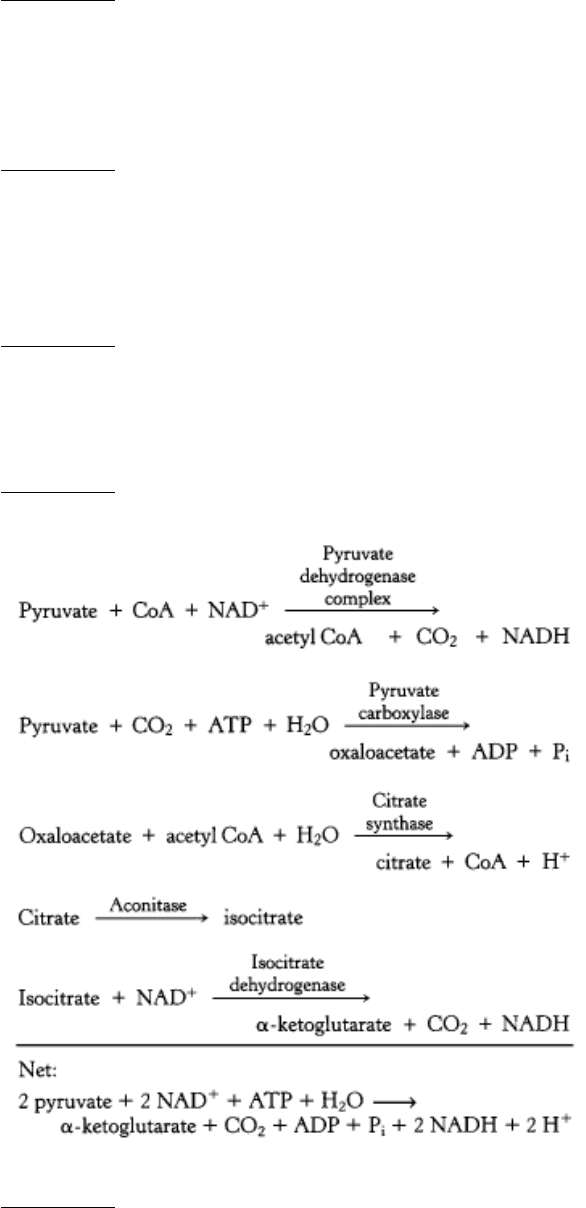
5.
The coenzyme stereospecificity of glyceraldehyde 3-phosphate dehydrogenase is the opposite of that of alcohol
dehydrogenase
See question
6.
Thiamine thiazolone pyrophosphate is a transition-state analog. The sulfur-containing ring of this analog is
uncharged, and so it closely resembles the transition state of the normal coenzyme in thiamine-catalyzed reactions (e.
g., the uncharged resonance form of hydroxyethyl-TPP).
See question
7.
A decrease in the amount of O
2
will necessitate an increase in anaerobic glycolysis for energy production, leading to
the generation of a large amount of lactic acid. Under conditions of shock, the kinase inhibitor is administered to
ensure that pyruvate dehydrogenase is operating maximally.
See question
8.
(a) The steady-state concentrations of the products are low compared with those of the substrates. (b) The ratio of
malate to oxaloacetate must be greater than 1.75 × 10
4
for oxaloacetate to be formed.
See question
9.
See question
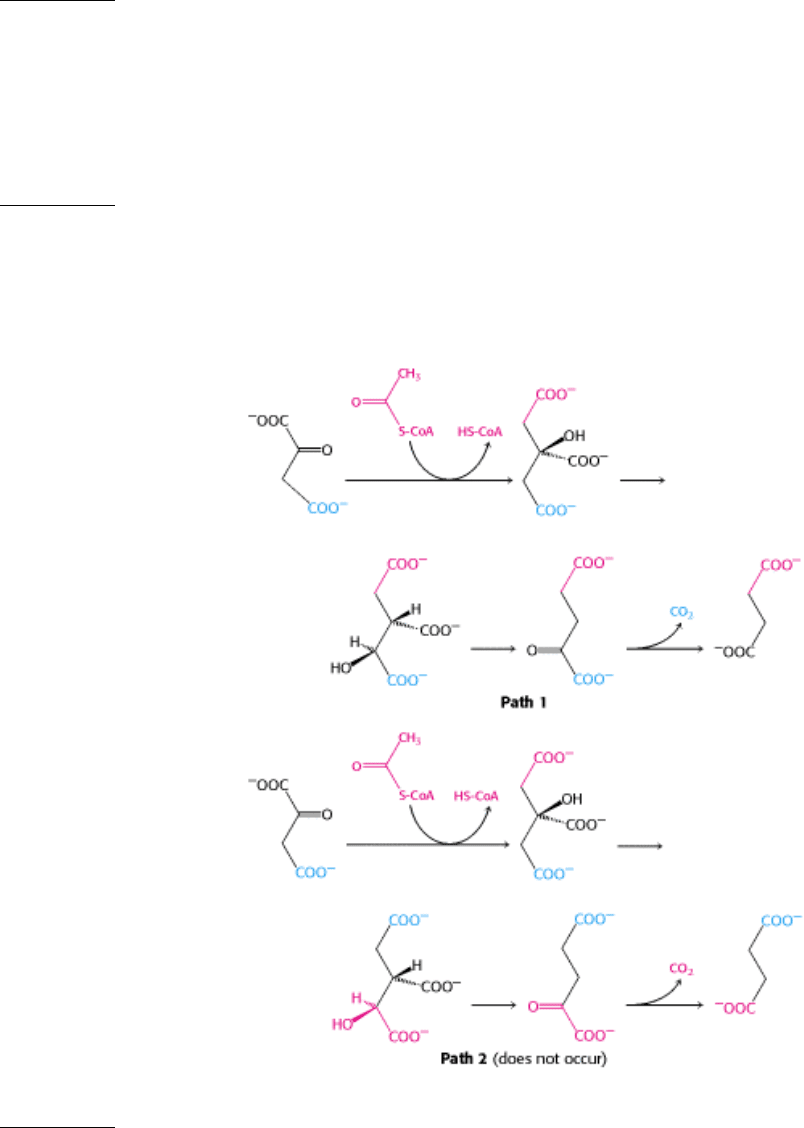
10.
We cannot get the net conversion of fats into glucose because the only means to get the carbons from fats into
oxaloace-tate, the precursor to glucose, is through the citric acid cycle. However, although two carbon atoms enter
the cycle as acetyl CoA, two carbon atoms are lost as CO
2
before oxaloacetate is formed. Thus, although some
carbon atoms from fats may end up as carbon atoms in glucose, we cannot obtain a net synthesis of glucose from
fats.
See question
11.
The enol intermediate of acetyl CoA attacks the carbonyl carbon atom of glyoxylate to form a C-C bond. This
reaction is like the condensation of oxaloacetate with the enol intermediate of acetyl CoA in the reaction catalyzed
by citrate synthase. Glyoxylate contains a hydrogen atom in place of the -CH
2
COO
-
group of oxaloacetate; the
reactions are otherwise nearly identical.
See question
12.
Citrate is a symmetric molecule. Consequently, it was assumed that the two -CH
2
COO
-
groups in it would react
identically. Thus, for every citrate molecule undergoing the reactions shown in path 1, it was thought that another
citrate molecule would react as shown in path 2. If so, then only half the label should have emerged in the CO
2
.
See question
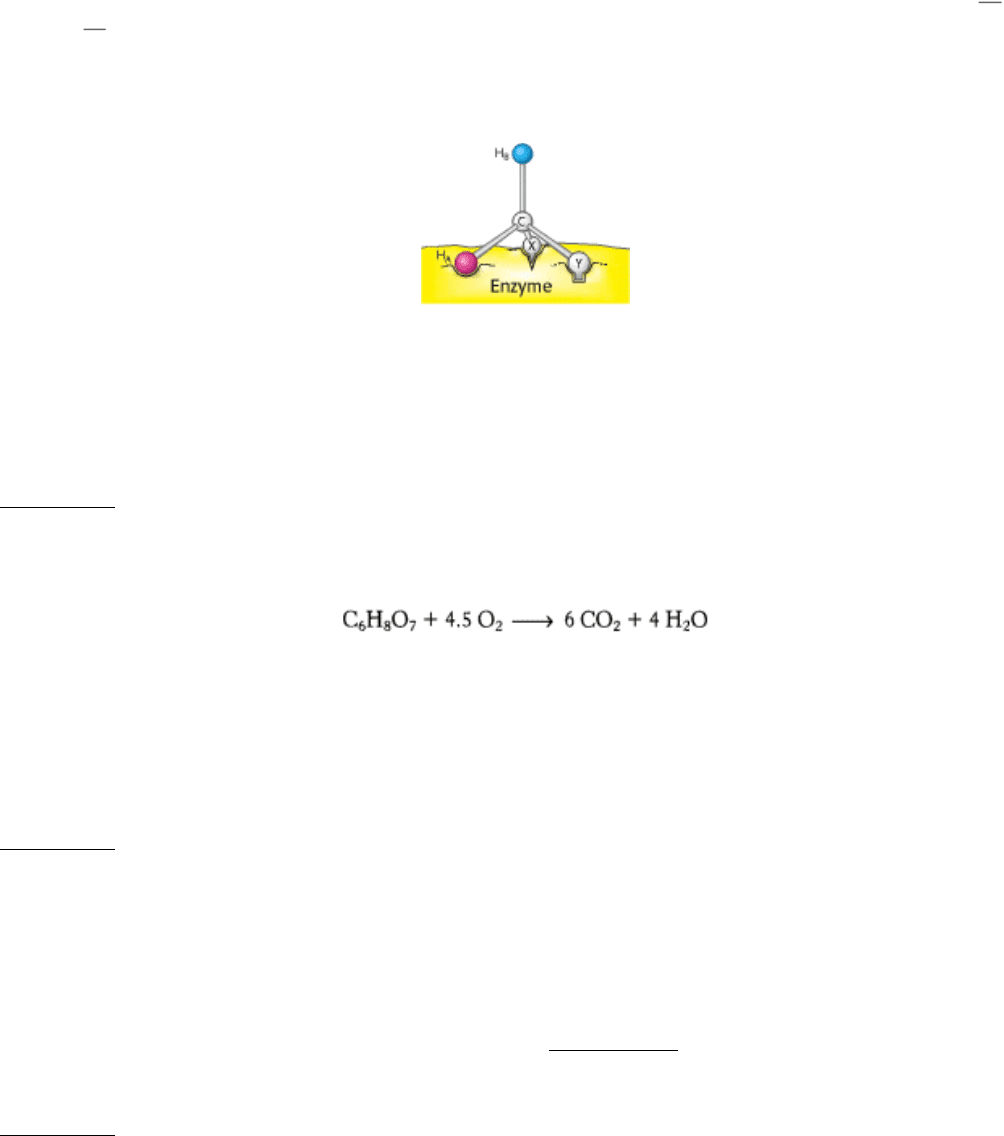
13.
Call one hydrogen atom A and the other B. Now suppose that an enzyme binds three groups of this substrate X,
Y, and H at three complementary sites. The adjoining diagram shows X, Y, and H
A
bound to three points on the
enzyme. In contrast, X, Y, and H
B
cannot be bound to this active site; two of these three groups can be bound, but
not all three. Thus, H
A
and H
B
will have different fates.
Sterically nonequivalent groups such as H
A
and H
B
will almost always be distinguished in enzymatic reactions.
The essence of the differentiation of these groups is that the enzyme holds the substrate in a specific orientation.
Attachment at three points, as depicted in the diagram, is a readily visualized way of achieving a particular
orientation of the substrate, but it is not the only means of doing so.
See question
14.
(a) The complete oxidation of citrate requires 4.5 µmol of O
2
for every µ mol of citrate.
Thus, 13.5 µmol of O
2
would be consumed by 3 µmol of citrate.
(b) Citrate led to the consumption of far more O
2
than can be accounted for simply by the oxidation of citrate itself.
Citrate thus facilitated O
2
consumption.
See question
15.
(a) In the absence of arsenite, the amount of citrate remained constant. In its presence, the concentration of citrate
fell, suggesting that it was being metabolized.
(b) It is not altered. Citrate still disappears.
(c) Arsenite is preventing the regeneration of citrate. Recall (Section 17.3.2) that arsenite inhibits the pyruvate
dehydrogenase complex.
See question

16.
(a) The initial infection is unaffected by the absence of isocitrate lyase, but the absence of this enzyme inhibits the
latent phase of the infection.
(b) Yes.
(c) A critic could say that, in the process of deleting the isocitrate lyase gene, some other gene was damaged, and it
is the absence of this other gene that prevents latent infection. Reinserting the isocitrate lyase gene into the bacteria
from which it had been removed renders the criticism less valid.
(d) Isocitrate lyase enables the bacteria to synthesize carbohydrates that are necessary for survival, including
carbohydrate components of the cell membrane.
See question
Answers to Problems
Chapter 18
1.
(a) 12.5; (b) 14; (c) 32; (d) 13.5; (e) 30; (f) 16.
See question
2.
Biochemists use E
0
, the value at pH 7, whereas chemists use E
0
, the value in 1 M H
+
. The prime denotes that pH 7
is the standard state.
See question
3.
(a) Blocks electron transport and proton pumping at Complex III. (b) Blocks electron transport and ATP synthesis by
inhibiting the exchange of ATP and ADP across the inner mitochondrial membrane. (c) Blocks electron transport
and proton pumping at Complex I. (d) Blocks ATP synthesis without inhibiting electron transport by dissipating the
proton gradient. (e) Blocks electron transport and proton pumping at Complex III. (f) Blocks electron transport and
proton pumping at Complex II.
See question
4.
If the proton gradient is not dissipated by the influx of protons into a mitochondrion with the generation of ATP,
eventually the outside of the mitochondrion develops such a large positive charge that the electron-transport chain
can no longer pump protons against the gradient.
See question

5.
(a) No effect. Mitochondria cannot metabolize glucose.
(b) No effect. No fuel is present to power the synthesis of ATP.
(c) The [O
2
] falls because citrate is a fuel and ATP can be formed from ADP and P
i
.
(d) Oxygen consumption stops because oligomycin inhibits ATP synthesis, which is coupled to the activity of the
electron-transport chain.
(e) No effect for the reasons given in part d.
(f) [O
2
] falls rapidly because the system is uncoupled and does not require ATP synthesis to lower the proton-motive
force.
(g) [O
2
] falls at a lower rate but still falls. Rotenone inhibits Complex I, but the presence of succinate will enable
electrons to enter at Complex II.
(h) Oxygen consumption ceases because Complex IV is inhibited and the entire chain backs up.
See question
6.
(a) The P:O ratio is equal to the product of (H
+
/2 e
-
) and (~P/H
+
). Note that the P:O ratio is identical with the (P:2 e
-
) ratio. (b) 2.5 and 1.5, respectively.
See question
7.
∆ G°
is +16.1 kcal mol
-1
(67 kJ mol
-1
) for oxidation by NAD
+
and +1.4 kcal/mol
-1
(5.9 kJ mol
-1
) for oxidation by
FAD. The oxidation of succinate by NAD
+
is not thermodynamically feasible.
See question
8.
Cyanide can be lethal because it binds to the ferric form of cytochrome oxidase and thereby inhibits oxidative
phosphorylation. Nitrite converts ferrohemoglobin into ferrihemoglobin, which also binds cyanide. Thus,
ferrihemoglobin competes with cytochrome oxidase for cyanide. This competition is therapeutically effective
because the amount of ferrihemoglobin that can be formed without impairing oxygen transport is much greater than
the amount of cytochrome oxidase.
See question
9.
The available free energy from the translocation of two, three, and four protons is -9.2, -13.8, and -18.5 kcal mol
-1
(-
38.5, -57.7, and -77.4 kJ mol
-1
), respectively. The free energy consumed in synthesizing a mole of ATP under
standard conditions is 7.3 kcal. Hence, the residual free energy of -1.93, -6.5, and -11.2 kcal (-8.1, -27.2, and -46.7
kJ mol
-1
) can drive the synthesis of ATP until the [ATP]/[ADP][P
i
] ratio is 26.2, 6.5 × 10
4
, and 1.6 × 10
8
,
respectively. Suspensions of isolated mitochondria synthesize ATP until this ratio is greater than 10
4
, which shows
that the number of protons translocated per ATP synthesized is at least three.
See question
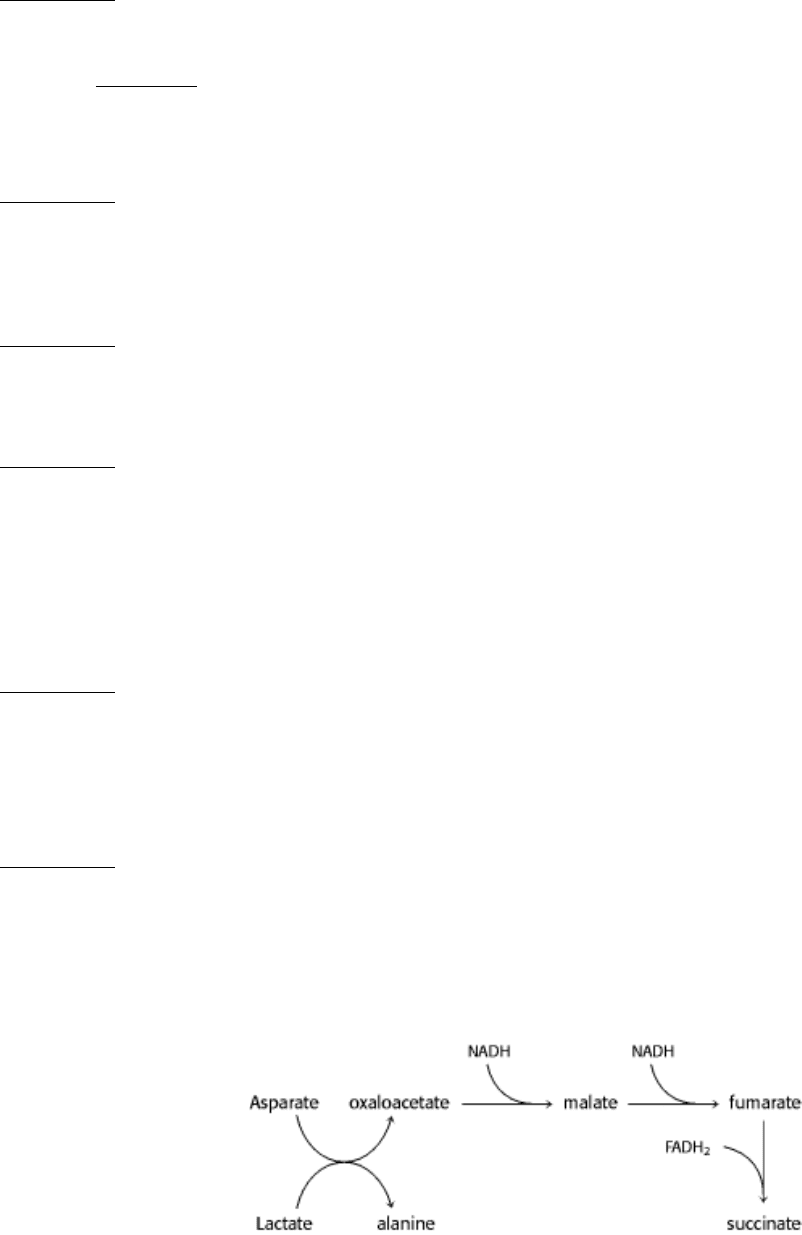
10.
Such a defect (called Luft syndrome) was found in a 38-year-old woman who was incapable of performing
prolonged physical work. Her basal metabolic rate was more than twice normal, but her thyroid function was
normal. A muscle biopsy showed that her mitochondria were highly variable and atypical in structure. Biochemical
studies then revealed that oxidation and phosphorylation were not tightly coupled in these mitochondria. In this
patient, much of the energy of fuel molecules was converted into heat rather than ATP.
See question
11.
Dicyclohexylcarbodiimide reacts readily with carboxyl groups, as discussed earlier in regard to its use in peptide
synthesis (Section 4.4). Hence, the most likely targets are aspartate and glutamate side chains. In fact, aspartate 61
of subunit c of E. coli F
0
is specifically modified by this reagent. Conversion of this aspartate into asparagine by
site-specific mutagenesis also eliminated proton conduction.
See question
12.
Triose phosphate isomerase converts dihydroxyacetone phosphate (a potential dead end) into glyceraldehyde 3-
phosphate (a mainstream glycolytic intermediate).
See question
13.
This inhibitor (like antimycin A) blocks the reduction of cytochrome c
1
by QH
2
, the crossover point.
See question
14.
If oxidative phosphorylation were uncoupled, no ATP could be produced. In a futile attempt to generate ATP,
much fuel would be consumed. The danger lies in the dose. Too much uncoupling would lead to tissue damage in
highly aerobic organs such as the brain and heart, which would have severe consequences for the organism as a
whole. The energy that is normally transformed into ATP would be released as heat. To maintain body temperature,
sweating might increase, although the very process of sweating itself depends on ATP.
See question
15.
Add the inhibitor with and without an uncoupler, and monitor the rate of O
2
consumption. If the O
2
consumption
increases again in the presence of inhibitor and uncoupler, the inhibitor must be inhibiting ATP synthase. If the
uncoupler has no effect on the inhibition, the inhibitor is inhibiting the electron-transport chain.
See question
16.
The organic acids in the blood are indications that the mice are deriving a large part of their energy needs through
anaerobic glycolysis. Lactate is the end product of anaerobic glycolysis. Alanine is an aminated transport form of
lactate. Alanine formation plays a role in succinate formation, which is caused by the reduced state of the
mitochondria.
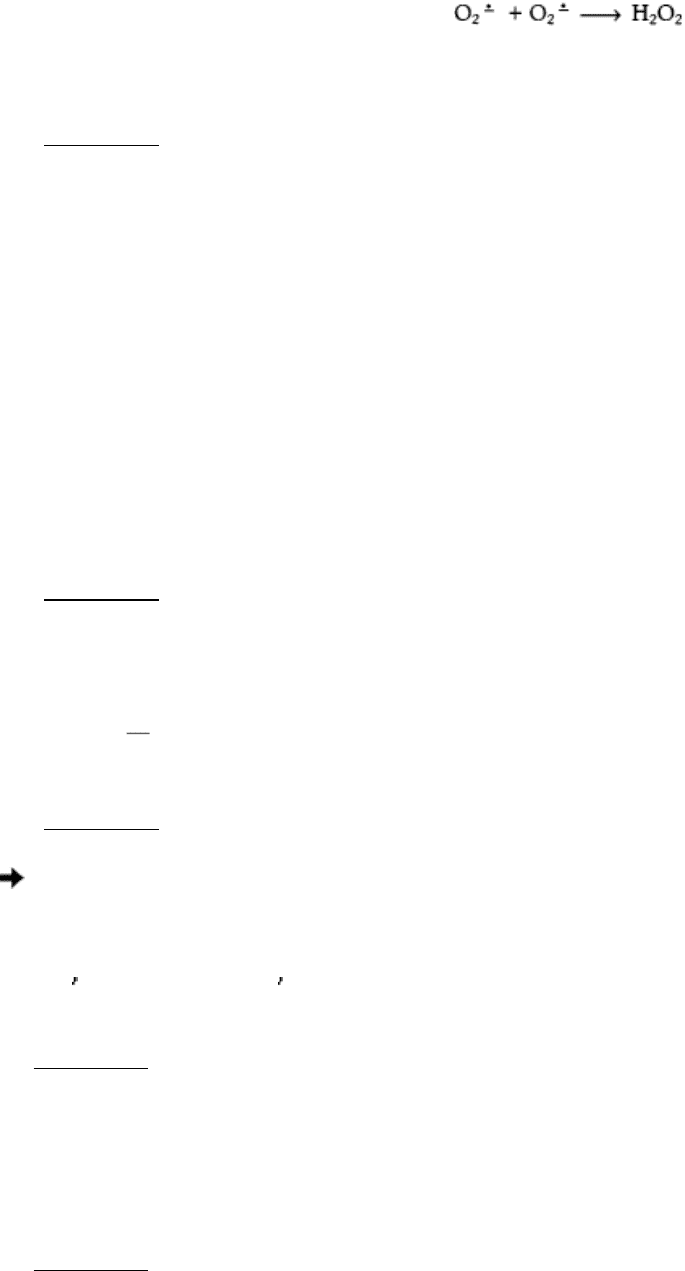
The electron-transport chain is slowed because the inner mitochondrial membrane is hyperpolarized. Without ADP
to accept the energy of the proton-motive force, the membrane becomes polarized to such an extent that protons can
no longer be pumped. The excess H
2
O
2
is probably due to the fact the superoxide radical is present in higher
concentration because the oxygen can no longer be effectively reduced.
Indeed, these mice display evidence of such oxidative damage.
See question
17.
(a) Succinate is oxidized by Complex II, and the electrons are used to establish a proton-motive force that powers
ATP synthesis.
(b) The ability to synthesize ATP is greatly reduced.
(c) Because the goal was to measure ATP hydrolysis. If succinate had been added in the presence of ATP, no
reaction would have taken place, because of respiratory control.
(d) The mutation has little effect on the ability of the enzyme to catalyze the hydrolysis of ATP.
(e) They suggest two things: (1) the mutation did not affect the catalytic site on the enzyme, because the ATP
synthase is still capable of catalyzing the reverse reaction; (2) the mutation did not affect the amount of enzyme
present, given that the controls and patients had similar amounts of activity.
See question
18.
The absolute configuration of thiophosphate indicates that inversion at phosphorus has occurred in the reaction
catalyzed by ATP synthase. This result is consistent with an in-line phosphoryl transfer reaction taking place in a
single step. The retention of configuration in the Ca
2+
-ATPase reaction points to two phosphoryl transfer
reactions
inversion by the first and a return to the starting configuration by the second. The Ca
2+
-ATPase
reaction proceeds by a phosphorylated enzyme intermediate.
See question
Answers to Problems
Chapter 19
1.
∆ E
0
= +0.11 V and ∆ G° = -5.1 kcal mol
-1
(-21.3 kJ mol
-1
).
See question
2.
(a) All ecosystems require an energy source from outside the system, because the chemical-energy sources will
ultimately be limited. The photosynthetic conversion of sunlight is one example of such a conversion.
(b) Not at all. Spock would point out that chemicals other than water can donate electrons and protons.
See question

3.
DCMU inhibits electron transfer in the link between photosystems II and I. O
2
can evolve in the presence of DCMU
if an artificial electron acceptor such as ferricyanide can accept electrons from Q.
See question
4.
DCMU will have no effect, because it blocks photosystem II, and cyclic photophosphorylation uses photosystem I
and the cytochrome bf complex.
See question
5.
(a) 28.7 kcal einstein
-1
(120 kJ einstein
-1
).
(b) 1.24 V.
(c) One 1000-nm photon has the free energy content of 2.4 molecules of ATP. A minimum of 0.42 photon is needed
to drive the synthesis of a molecule of ATP.
See question
6.
At this distance, the expected rate is one electron per second.
See question
7.
Phycoerythrin, the most peripheral protein in the phycobilisome.
See question
8.
The distance doubles, and so the rate should decrease by a factor of 64 to 640 ps.
See question
9.
The electrons flow through photosystem II directly to ferricyanide. No other steps are required.
See question
10.
(a) Thioredoxin.
(b) The control enzyme is unaffected, but the mitochondrial enzyme with part of the chloroplast γ subunit increases
activity as the concentration of DTT increases.
(c) The increase was even larger when thioredoxin was present. Thioredoxin is the natural reductant for the
chloroplast enzyme, so presumably it operates more efficiently than would DTT, which probably functions to keep
the thioredoxin reduced.
(d) It seems that they did.
(e) The enzyme is susceptible to control by the redox state. In plant cells, reduced thioredoxin is generated by
photosystem I. Thus, the enzyme is active when photosynthesis is taking place.
(f) Cysteine.
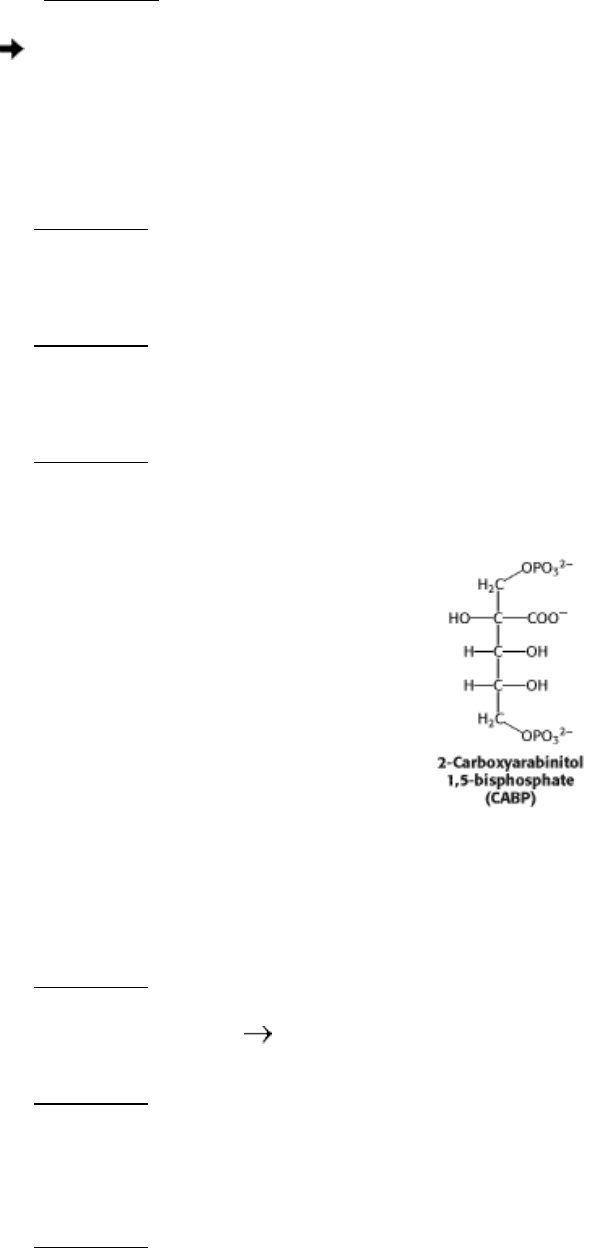
(g) Group-specific modification or site-specific mutagenesis.
See question
Answers to Problems
Chapter 20
1.
Aldolase participates in the Calvin cycle, whereas transaldolase participates in the pentose phosphate pathway.
See question
2.
The concentration of 3-phosphoglycerate would increase, whereas that of ribulose 1,5-bisphosphate would decrease.
See question
3.
The concentration of 3-phosphoglycerate would decrease, whereas that of ribulose 1,5-bisphosphate would increase.
See question
4.
(a)
(b) CABP resembles the addition compound formed in the reaction of CO
2
and ribulose 1,5-bisphosphate.
(c) CABP is predicted to be a potent inhibitor of rubisco.
See question
5.
Aspartate + glyoxylate oxaloacetate + glycine
See question
6.
ATP is converted into AMP. To convert this AMP back into ATP, two molecules of ATP are required: one to form
ADP and another to form ATP from the ADP.
See question

7.
The oxygenase activity of rubisco increases with temperature. Crabgrass is a C
4
plant, whereas most grasses lack
this capability. Consequently, the crabgrass will thrive at the hottest part of the summer because the C
4
pathway
provides an ample supply of CO
2
.
See question
8.
As global warming progresses, C
4
plants will invade the higher latitudes, whereas C
3
plants will retreat to cooler
regions.
See question
9.
The label emerges at C-5 of ribulose 5-phosphate.
See question
10.
Oxidative decarboxylation of isocitrate to α-ketoglutarate. A β-ketoacid intermediate is formed in both reactions.
See question
11.
C-1 and C-3 of fructose 6-phosphate are labeled, whereas erythrose 4-phosphate is not labeled.
See question
12.
(a) 5 Glucose 6-phosphate + ATP
6 ribose 5-phosphate + ADP + H
+
(b) Glucose 6-phosphate + 12 NADP
+
+ 7 H
2
O 6 CO
2
+ 12 NADPH + 12 H
+
+
P
i
See question
13.
Form a Schiff base between a ketose substrate and transaldolase, reduce it with tritiated NaBH
4
, and fingerprint the
labeled enzyme.
See question
14.
∆ E
0
for the reduction of glutathione by NADPH is +0.09 V. Hence, ∆ G° is -4.2 kcal mol
-1
(-17.5 kJ mol
-1
),
which corresponds to an equilibrium constant of 1126. The required [NADPH]/[NADP
+
] ratio is 8.9 × 10
-2
.
See question
